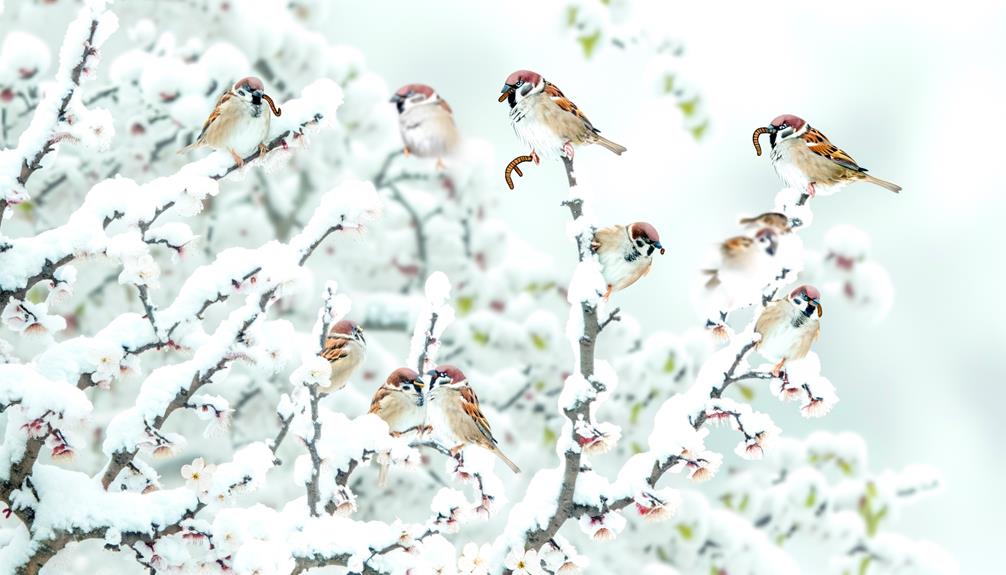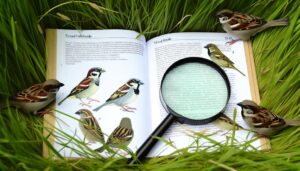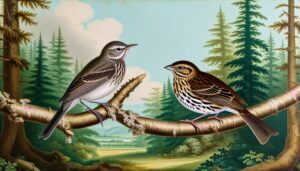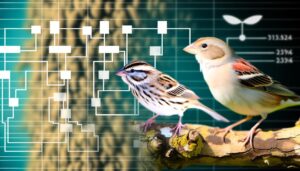3 Fun Facts About Tree Sparrows
Tree Sparrows, or Passer montanus, exhibit a distinctive brown back and double wing bars. They're roughly 14cm long and both genders share similar plumage.
Remarkably adaptable, their diet shifts seasonally between seeds and protein-rich insects. They're known for their intricate social hierarchies and specifically, dominant males.
Communication occurs through distinct vocalizations and territorialism is common in nest defence. Their short-distance migration patterns are mainly influenced by food accessibility, showcasing their adaptability.
Interestingly, their mating rituals involve courtship dances and melodious songs unique to each male. As you further explore, you'll discover more fascinating aspects of these creatures.

Key Takeaways
- Tree Sparrows have a complex social hierarchy, with dominant males leading the group.
- They are partial migrants, moving short distances based on food availability instead of weather changes.
- Their diet includes seeds, insects, and even supplemental food from bird feeders.
- Tree Sparrows engage in courtship dances and vocal displays, with each male having a unique song.
- They are adaptable and change their behavior based on environmental threats or changes.
Tree Sparrow's Unique Characteristics
The tree sparrow, displaying a charming mix of warm chestnut, white and black colors, possesses several unique characteristics that distinguish it from other bird species.
Scientifically known as Passer montanus, it's smaller than the house sparrow with a length of approximately 14 cm. Unlike its relatives, it has an unstreaked chestnut back and an unbroken black eye stripe that runs across its white cheeks.
The male and female tree sparrows are alike in plumage, a feature that deviates from the norm in bird species. Their distinct double wing bars also set them apart.
Their habitat preference is another unique trait. They're commonly found in farmlands and deciduous forests, often near water. With an estimated lifespan of 3 years, tree sparrows are a fascinating avian species.
The Diet of a Tree Sparrow
Diving into the dietary habits of tree sparrows, it's worth noting that they primarily feed on seeds and insects, making them an integral part of their ecosystem. They're opportunistic feeders, shifting their diet according to seasonal availability.
During the colder months, seeds from grasses and crops constitute their main food source. However, in the breeding season, they switch to a protein-rich diet of insects to nourish their young.
Tree sparrows also partake in grit, small stones, to aid in digestion. They're known to consume supplemental food from bird feeders, particularly in winter. This dietary flexibility safeguards their survival in diverse habitats and conditions.
Understanding Tree Sparrow's Behavior
Observing tree sparrows in their natural habitat reveals intriguing patterns and nuances in their behavior, providing a window into their social structures and survival strategies. These birds exhibit a complex social hierarchy, with dominant males leading groups and protecting territories. They communicate through a variety of vocalizations, each with specific meanings, and are known for their adaptability, often altering their behavior in response to changes in their environment or threats.
To better comprehend their behavior, consider this table:
| Behavior | Meaning | Example |
|---|---|---|
| Vocalizations | Communication | Warning calls |
| Territoriality | Dominance | Males defending nests |
| Adaptability | Survival | Altering behavior based on environment |
With the understanding of these behaviors, one can appreciate the intricate nature of these small yet complex creatures.
Tree Sparrow's Fascinating Mating Rituals
Intricate and intriguing, tree sparrow's mating rituals showcase a blend of courtship dances, vocal displays, and territorial assertions that highlight their complex social dynamics. Male sparrows initiate the process, sweeping into elaborate aerial displays designed to capture the female's attention. They're not just showing off their flight skills; this dance also demonstrates their fitness and suitability as a mate.
Their vocal performances are equally compelling. Males produce a distinctive, melodious song, unique to each individual, serving as an acoustic badge of identity. The richer and more varied the song, the higher the male's chances of attracting a mate.
Territoriality also plays an essential role. Males defend their chosen nesting sites fiercely, driving off rivals. This aggression signifies their commitment and resourcefulness, key traits desired by potential female partners.
The Migration Patterns of Tree Sparrows
While the mating rituals of tree sparrows unquestionably reveal much about their social dynamics, their migration patterns offer invaluable insights into their adaptability and survival strategies.
Unlike many bird species, tree sparrows don't migrate long distances. Instead, they're partial migrants, moving short distances from their breeding areas to wintering grounds, usually within a 30-50 km range. Their migration time is largely influenced by food availability rather than climatic changes. During harsh winters, they're known to migrate even further south in search of food. They tend to return to their breeding grounds by early spring.
This pattern demonstrates the species' flexibility and resilience, key factors in their survival, particularly in changing environmental conditions.
Tree Sparrow: A Songbird's Melody
The Tree Sparrow, an engrossing songbird, produces a unique melody that serves a dual role, which encompasses more than just a pleasant sound to human ears.
It's this melody that forms the basis of their communication, making it a critical aspect of their survival.
Further, the implications of this melody on the bird's behavior provide an absorbing topic of study, presenting an intriguing intersection of biology and acoustics.
Tree Sparrow's Unique Song
Despite their small size, tree sparrows create a complex and melodious song that's unique to their species. This song, often characterized by a series of chirps and trills, showcases the bird's vocal prowess. It's a symphony of sounds, ranging from short, sharp notes to longer, more melodious ones.
Researchers have identified distinct patterns, revealing that a tree sparrow's song contains several repeating elements. The frequency modulation, or changes in pitch, within these elements is what makes each song unique. It's this distinctive combination of notes and rhythms that sets the tree sparrow's song apart from others in the avian world.
This song isn't just a beautiful melody, but an auditory signature, a proof of the tree sparrow's unique place in nature's choir.
Melody Vs. Communication
Shifting our focus from the melodic aspect of tree sparrow's song, we now explore its role in communication, an equally fascinating area of study.
The tree sparrow's song isn't just pleasing to the ear; it serves a key purpose in conveying messages to other sparrows. This avian language varies, with different tones and sequences acting as distinct signals. High-pitched trills may denote warning, while softer coos often express contentment.
Scientists also note that male sparrows use specific melodies to attract mates, indicating that there's a profound relationship between their song's musicality and its communicative function.
Therefore, the tree sparrow's song is an intricate blend of melody and communication, a reflection of the complexity of these birds' social interactions.
Songbird's Melody: Behavioural Implications
Interestingly, tree sparrows' melodious songs aren't just for display—they're a crucial element in their behavioral patterns and social interactions.
A sparrow's song is a sophisticated communication tool, used primarily for two purposes: attracting mates and defending territories. When a male sparrow sings, it's often a demonstration of energy meant to attract a potential partner. The complexity and strength of the song can indicate the quality of the singer, influencing female choice.
In terms of territory defense, a sparrow's song serves as a warning to other males. A powerful, consistent melody indicates a strong, dominant bird, deterring rivals from infiltrating its territory. As a result, a tree sparrow's song isn't just pleasing to the ear, but a crucial behavioral tool.
Lifespan and Survival of Tree Sparrows
Tree Sparrows typically live up to three years in the wild, although their survival rates hinge heavily on environmental factors and predator presence. Their lifespan can be notably reduced due to harsh weather conditions, scarcity of food sources, and increased predation. These small birds are the prey of larger birds and mammals, making their survival a constant battle.
Scientific studies have observed an alarming decline in Tree Sparrow populations in certain regions, primarily due to changes in farming practices that affect their habitat. Pesticide use, for instance, can diminish their food sources and indirectly impact their survival.
Indeed, the lifespan and survival of Tree Sparrows are intricately tied to the delicate balance of their ecosystem.
The Role of Tree Sparrows in Ecosystem
Tree sparrows exert significant influence on ecosystems through seed dispersion and insect control. Their foraging habits lead to the scattering and germination of various plant seeds, thereby promoting biodiversity.
Equally, their diet of insects aids in maintaining a balance in insect populations, preventing potential overpopulation and associated ecological consequences.
Tree Sparrows: Seed Dispersion
Playing an important role in their ecosystems, tree sparrows assist in seed dispersion, contributing greatly to the propagation and diversity of plant life. They're skilled foragers, consuming seeds of various sizes and types. During foraging, seeds adhere to their feet or feathers, or pass through their digestive systems, and are then deposited in different locations.
This inadvertent dispersal of seeds aids in the spread of many plant species. Their droppings also contribute to seed germination by providing a nutrient-rich environment. In this way, tree sparrows indirectly influence the structure and composition of plant communities. Their role is especially vital in maintaining diversity in forest habitats, underlining the importance of these small birds in large-scale ecological processes.
Insect Control by Sparrows
In their quest for nourishment, these feathered creatures also serve as efficient insect controllers, greatly reducing the population of harmful pests in their habitats. Tree Sparrows consume a wide variety of insects, particularly during the breeding season when the demand for protein is high.
- They primarily feed on aphids, caterpillars, beetles, and flies, reducing these pest populations and limiting their harmful effects on vegetation.
- The consumption of insects also aids in the natural control of diseases that these pests may carry.
- Tree Sparrows' feeding habits contribute to the balance of the ecosystem, maintaining biodiversity by controlling insect populations.
- The presence of Tree Sparrows can indicate a healthy insect population, as they thrive in areas with plentiful food sources.
Their role in insect control demonstrates the interconnectedness of species within an ecosystem.
Threats and Conservation Efforts
What challenges do these delicate creatures face, one might ask? Tree sparrows are threatened by several factors, including habitat loss due to urbanization and agriculture. Pesticide exposure also poses a significant risk, as it can lead to decreased insect populations, their primary food source. Climate change, too, impacts their survival, disrupting breeding patterns and altering habitats.
To counter these threats, conservation efforts are underway. Policies are being implemented to regulate pesticide use and promote organic farming. Efforts are also focused on preserving and restoring habitats, including the creation of sparrow-friendly environments in urban areas. Additionally, climate change mitigation strategies are being pursued globally.
Despite these challenges, the resilience of tree sparrows, coupled with concerted conservation efforts, offers hope for their future survival.
Interesting Tree Sparrow Folklore
Delving into the world of folklore reveals fascinating tales and beliefs surrounding tree sparrows, varying greatly across different cultures and societies. These small birds have been imbued with symbolism and featured in many legends, often representing positivity, prosperity, and harmony.
Some of the most intriguing folklore includes:
- In Chinese culture, sparrows symbolize joy and protection, believed to bring good luck.
- Japanese tradition holds sparrows as symbols of loyalty due to their social nature.
- In European folklore, sparrows are often seen as bearers of love, representing the soul of the deceased.
- Native American legends associate sparrows with trust and innocence, their chirping interpreted as joyful news.
These cultural tales not only entertain but also shed light on how societies perceive and relate to nature.
Conclusion
In the grand tapestry of nature, tree sparrows play an essential, often overlooked role. With their unique characteristics, fascinating behavior, and intriguing mating rituals, they add a touch of color and curiosity.
As they flutter through their migratory routes, they aid in maintaining ecological balance. Despite facing threats, their resilience shines. Nestled within folklore, these tiny creatures inspire awe.
In understanding and conserving tree sparrows, we not only protect them, but also the delicate equilibrium of our shared ecosystem.






